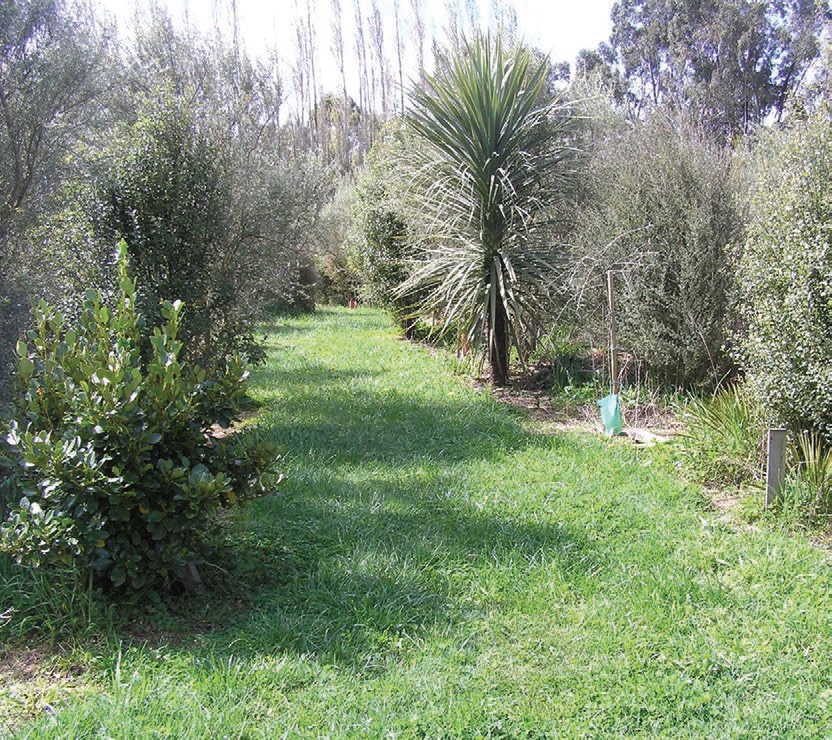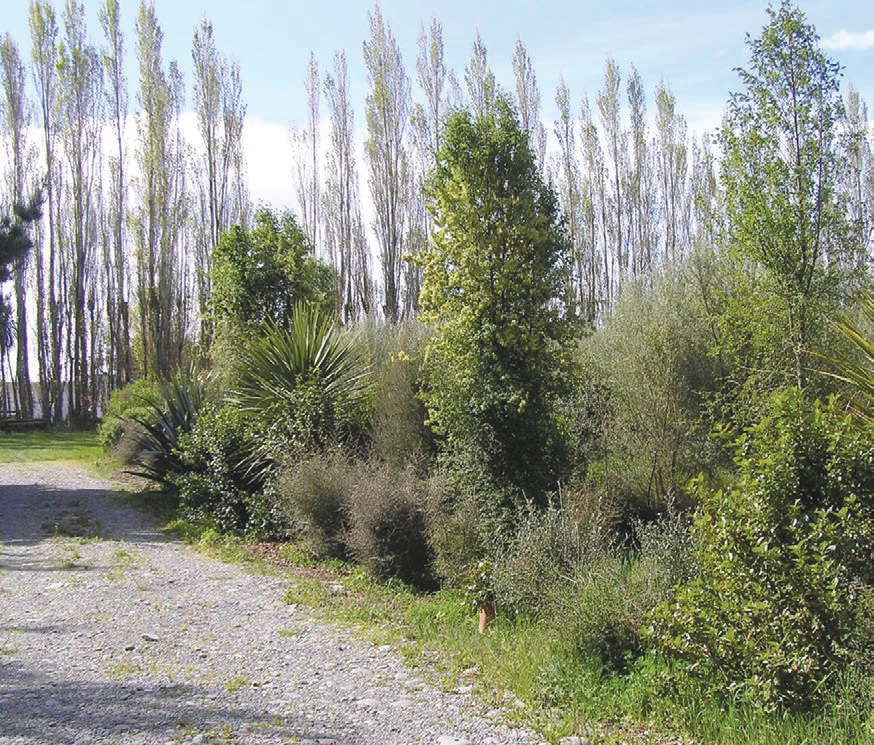West Melton bush block
Peter Gatehouse, New Zealand Tree Grower August 2015.
The open Canterbury Plain is not the easiest site to create a new native forest. Strong cold easterlies, desiccating north-westerlies, frost and periodic snow are major factors for survival. In addition, many of the shallow soils of the plains are low in fertility and often have a significant quantity of stone, sand and silt.
This results in a soil which is very prone to drought. There are exceptions. At the coast and in the foothills, the soils often have higher water tables with clay and peat loams, and therefore have a significantly better water holding capacity. It can be difficult to get a native community going, and I look with envy at some of the sheltered valleys and sites with better soils.
No irrigation
I have been planting natives on difficult sites for over 30 years with some success, and it is with this background I was invited to plant a two hectare grassy paddock with indigenous Canterbury origin trees and shrubs. Fortunately, the site had higher quality soils than usual for the area with deep, fertile loam and no stones. This soil has a reasonable water holding capacity compared to others. In addition the proposed site has some tree shelter. To the north was a tall poplar shelterbelt, the north west was protected by some pine, and the easterly had a few eucalypts.
The plan was not to irrigate the plants, so by limiting the wind with shelter was important to reduce desiccation. Ground preparation involved first ripping all the shelter within two metres of the trunks and leaving a buffer of four metres should further ripping be needed. I should say here that I am constantly amazed at the competition which you get from shelterbelts. Traditional species such as, poplar, macrocarpa, eucalypts and pines can extend their roots a great distance and severely affect new planting as a result of root competition.
The whole area was sprayed with herbicide and supplementary fertiliser was added to assist the new plants. Species selection was interesting. We consulted nurseries, NZFFA members and others and decided on a multi-zoned approach for the planting.

Modelling after glaciation
Planting was in September because the soil would still be at or near field capacity, despite the fact that we might lose one or two to frost. Consideration was given to planting nurse species only in the first year, but we decided to plant most species at once, a total of 4,000 plants, providing that they were tough enough to cope in the open environment.
A feature of the species selection was the incorporation of some species now very rare on the plains, and perhaps reflects an historic ideal. The model we used was a plains plant association immediately post-glaciation, thousands of years ago when Canterbury was cooler and wetter than today. There is good historical evidence that the area was covered in a mixed forest of various types according to variation in soils, river and shelter, but occasionally destroyed by natural fires creating a patchwork landscape of beech, podocarp and broadleaf forest, scrub, grassland and swamp.
We chose three nursery plants, which we purchased in large numbers. They were Dartonii, kanuka and Pittosporum tenuifolium. Dartonii lineata (twiggy tree daisy) is the standout for speed and growth and survivability. It is an impressive shelter species, it is sterile, somewhat rambling in growth and can be pruned back to allow light for desirable species.
Kanuka was disappointing. We obtained plants from three nurseries but almost all performed poorly on this site, although some were better after four years. Pittosporum tenuifolium is excellent and tough and provided excellent shelter for delicate species. The only problem is that we seem to have a lot of garden hybrid varieties within the mix, as some had very small leaves and small compact growth.

Plant protection
The use of plant sleeves was universal. We have experimented with four different types but decided on a cut down 150 mm wide by 250 mm high sleeve held with three or four short bamboos. We tucked the bottom 20 mm up and put pea gravel in the cup to hold the sleeve down against strong winds. With the sleeves, rabbit or hare damage was zero.
Wool mulch and carpet was used on a few but to no advantage and was more expensive in time and money. The sleeves were essential for weed control as we can spray right up to the sleeve safely. I like to use a red colour in the mix as a marker and use a very coarse spray so that drift is minimised. About half the plants received some plant mulch although I feel that the effort was probably not worth it compared to spraying. We fully expected to be spraying some plants for two to three years, but in some cases we are still protecting delicate species after four. This weed control we regard as critical to the success of the plant survival and growth rate.
We experimented with plants of different grades, but overall revegetation grade are perfectly fine, although some looked incredibly small in the first year. Most were small pots or root trainers and planted with a slow release fertiliser tablet. We did put a few larger plants, some totara one metre grade, but feel the extra digging, stacking and cost did not provide a good advantage.
Our dominant plant species totara, beech, matai and kahikatea were planted at roughly three metres centres with nursery and others 1.5 metres between. A small experimental area had twice the density of this to see if weed suppression was better – and it was.
The edge of the new forest was planted with lower growing species to give a tapered outer edge. Species in this area included Phoruim tenax, Muehlenbeckia astonii, Coprosma virescens, Coprosma propinqua, Cordyline australis, Hebe salicifolia, Griselinia littoralis and Myrine divaricata. At the forest edge where there was a lower risk we have added wineberry, fuschia, five finger, toetoe and hebes. In the grassland area we planted swathes of, Poa cita, Carex, Chionochloa, with prostrate kowhai, matagouri, porupine shrub, speargrass and native broom.
Totara has grown particularly well and is a tough tree. We have planted local variations including Podocarpus hallii from Banks Peninsula, Malvern Hills and Plains. Colour and leaf variation are interesting. Similarly the variation in kowhai is considerable, leaf shape, form and the degree of divaricate habit are particularly striking.
Since year two we have progressively planted ferns, tree ferns, bellbird tree, rata, marble leaf, clematis and bush lawyer. Rare plants include titaki, hirau, libocedrus and rimu. Now in year four the highest trees, beech, are over four metres. Weed suppression is happening naturally and many plants are flowering and seeding including two totara.
Irrigation a reality
Except for understory planting and the occasional replacement, planting has stopped and nature is dominating the environment created. I expect to cull one or two plants especially the Dartonii if it is crowding a forest tree or shrub. Irrigation has now become a reality. We have decided on a supplementary irrigation for summer. When appropriate using a big gun, flexible lines and six hydrants. Given time the trees will prevent this use so we may provide understory irrigation to provide insurance to this valuable planting. The dense planting will probably slowly diminish as nature provides its own competition. We fully expect some trees to succumb and some to survive.
We feel we have achieved what we set out to do. We have had a high survival rate of over 90 per cent, we have a high growth rate and we feel the block is sustainable even if the irrigation is not available long term. Plants are providing their own shade and for understory plants and there is food, shelter and nests, opportunities for native birds. We now have over 5,000 plants and over 80 species, and we have seen our first bellbird, a rare local visitor. Things are looking good.
This article was first published in Indigena.

 Farm Forestry New Zealand
Farm Forestry New Zealand